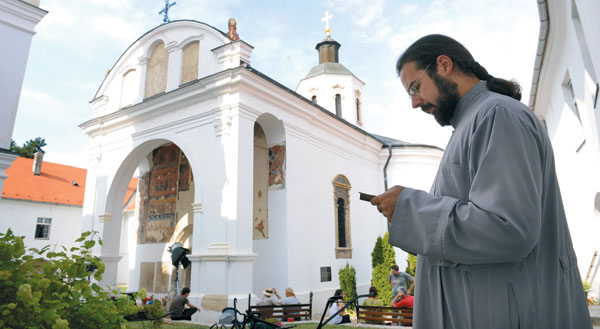
Days


Days
DAY 1. – Rakovica Monastery
Arrival in Belgrade and check-in at the Rakovica Monastery. Transfer from the airport to Rakovica Monastery followed by a Serbian national dinner and overnight at the Rakovica Monastery.
DAY 2 – Belgrade Churches
Morning Service or liturgy at Rakovica Monastery. The Monastery and its church dedicated to St. Michael and Gabriel Archangels was built during the reign of Prince Lazar at end of 14th century. Today, this church is known as the place where the 44th Patriarch of Orthodox Church, Pavle – Paul, is buried. Sightseeing of Belgrade by walk, bus and river cruise. The Cathedral of Saint Sava or Saint Sava Temple in Vračar, Belgrade, is an Orthodox church, the largest in the Balkans, and one of the 10 largest church buildings in the world. The church is dedicated to Saint Sava, founder of the Serbian Orthodox Church and an important figure in medieval Serbia. Ružica Church – Rose church, is located in the Kalemegdan Fortress. A church of the same name existed on the site in the time of Stefan Lazarević. It was demolished in 1521 by the invading Ottoman Turks. Today’s church was a gunpowder magazine in the 18th century and was converted into a military church between 1867 and 1869. Heavily damaged during the First World War, the church was renovated in 1925. St. Petka`s Church – The construction of the building started in 1935. in place of an old chapel, above a spring which is considered to have miraculous powers. It was completed and revived on the day of St. Petka-Paraskeva, Visit the Museum of Serbia Orthodox Church and a wine cellar in the cave, built by Serbs in the 18th century. Lunch in Kaludjerica with Blagoje Ninkovic, manufacturer of icons. Return to the accommodation for a short rest. Dinner in Skadarlija at 2 Jelena Restaurant – Skadarlija is a vintage street, an urban neighborhood and former municipality of Belgrade, the capital of Serbia. Overnight at the Rakovica Monastery
DAY 3. – Manasija, Ravanica and Studenica
Manasija, Ravanica, Vrnjacka Spa and Studenica. Visit the monasteries Manasija and Ravanica, one of the most important monasteries in Serbia, which belongs to the worldwide oldest monasteries list, appreciated by its architecture and art. At the monastery, you find stunning iconostasis. The founder of the monastery is Despot Stefan Lazarevic, also known as Stefan High, who built the monastery between 1407. and 1418. Despot Stefan was well known as a ruler and a knight – a member of the famous Red Dragon Knight Order.
The Ravanica monastery was built in the 14th century by Despot Stefan Father, an emperor Lazar who was the leader of the Serbian Army during the Kosovo Battle in 1389. Lunch break. Holly Emperor Lazar – Ravanica, and his son Stefan – Manasija, are one of the most beloved leaders and dictators in the Serbian history. The road leads us to Vrnjacka Spa and Nebojsa Bogavac who is manufactured icons for churches in Oslo. Follows visit to the monastery Studenica, which is listed a UNESCO World Heritage Site. Overnight at Studenica Monastery.
DAY 4. – Gradac Monastery
Hermitage – anchoress – of Saint Sava and Gradac Monastery. Breakfast and visit to Hermitage of Saint Sava and Gradac Monastery. Gradac Monastery is situated in Stara Raška region, on the wooded and secluded slopes of Golija Mountain on the place called by locals Petrov Krs. Gradac Monastery was built in the late 13th century, on the ruins of an earlier church. Gradac Monastery is the endowment of Queen Jelena Anzujska /Queen Helen of Anjou/, probably from the Charles I Anjou Family, king of Sicily and Naples, the wife of the Serbian King Uros I. The Church of Gradac Monastery is dedicated to the Presentation of the Holy Virgin. The Church of Gradac Monastery is one nave structure with the dome, tripartite altar and rectangle choir, whose central part consists of two chapels, the main naos, and the altar. In the architecture of the shrine of Gradac Monastery that is example of monumental Raska school of architecture there are numerous Gothic /Romanesque/ elements, especially on the portals and on all bifocals /windows divided by a colonnette into two arches.
Overnight at Studenica Monastery, one of the world’s most beautiful monasteries, not just because of the refined architecture and art, but because it was built in phenomenal landscape.
DAY 5. – Tronosa and Kaona Monastery
Tronosa and Kaona Monasteries. Breakfast. Visit the Tronosa and Kaona Monastery. Lunch break. Overnight at Saint Nikolaj Monastery. The Tronosa Monastery was built during the beginning of the 14th century. The King Dragutin ordered the monastery to be built, after the death of his wife, Wueen Katarina, it was finished. It is famous for the Tronosa Chronicle, written in the 18th century, which is now kept in Viena.
Kaona Monastery, 100 km south-west from Belgrade, in the vicinity of Draginje village was built as legacy of Ikonia, the sister of Milos Obilic, famous Serbian hero who was killed in the Battle of Kosovo. The witness of the ancient time today Kaona Monastery is rebuilt and became spiritual center and gathering place of the Orthodox population.
DAY 6. – Fruska Gora
Breakfast. Visit some of the monasteries on the Fruska Gora Mountain, so called Serbian Holly Mountain with 16 monasteries from the 12th and 13th centuries. The tour continues to the small Baroque Town of Sremski Karlovci, a Serbian historical and cultural centre, where we will visit the main cathedral church which represents true gallery of art and the seat of Serbian Orthodox Church in the Habsburg Monarchy. Departure to Novi Sad and Petrovaradin Fortress, the second largest in Europe located on the Danube River. Return to the accommodation. Dinner. Overnight at Krusedol Monastery.
DAY 7. – Fruska Gora
Breakfast at the Krusedol Monastery, dated from the beginning of the 16th century. Nowadays, Krušedol Monastery is the Mausoleum of numerous significant historical persons, boasting graves of despots Brankovics, the Patriarch Arsenije the Third Carnojevich, the Patriarch Arsenije the Fourth Carnojevich, King Milan, Princess Ljubica Obrenovic and Duke Stevan Supljikac. Krusedol Monastery possesses rich collection of old precious icons, manuscripts, and printed books. The feast day of Krusedol Monastery is celebrated on the day of the Most Holy Mother Angelina of Serbia, on the 12th – 30th of August. Visit some of the monasteries on Fruska Gora Mountain. Return to Krusedol Monastery. Dinner. Overnight at Krusedol Monastery.
DAY 8.
Departure to Belgrade. Transfer to the airport.
Prices on request, we have special offers for you!
Customize your package.
What is included:

 Archeology in Serbia | 8 days
Archeology in Serbia | 8 days 